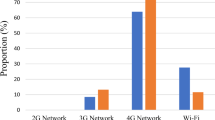Abstract
IN some recent experiments carried out for the Radio Research Board of the Department of Scientific and Industrial Research, measurements have been made of the diurnal variation of the signals received at Cambridge from the stations of the British Broadcasting Company. During the day-time these signals have been found to be fairly constant, but night-time variations of intensity have been measured at distances from the transmitter so short as 50 miles. For example, the signals from London at Cambridge are found to be constant during the day; but, at about sunset, variations, which are often of a periodic character, begin, and continue through the dark hours. In this case the mean night value is very little different from the day value. For more distant stations (for example, Bournemouth) the phenomena are different. During the day the signal is weak and constant; but after sunset the intensity increases and, though variable, the signal maxima may be several times the day value. In this case the variations in signal intensity are larger, less rapid, and less markedly periodic than in the case of the London signals.
This is a preview of subscription content, access via your institution
Access options
Subscribe to this journal
Receive 51 print issues and online access
$199.00 per year
only $3.90 per issue
Buy this article
- Purchase on Springer Link
- Instant access to full article PDF
Prices may be subject to local taxes which are calculated during checkout
Similar content being viewed by others
Author information
Authors and Affiliations
Rights and permissions
About this article
Cite this article
APPLETON, E., BARNETT, M. Local Reflection of Wireless Waves from the Upper Atmosphere. Nature 115, 333–334 (1925). https://doi.org/10.1038/115333a0
Issue Date:
DOI: https://doi.org/10.1038/115333a0
This article is cited by
-
IDA4D: Ionospheric Data Assimilation for the ICON Mission
Space Science Reviews (2020)
-
Space Weather: Historical and Contemporary Perspectives
Space Science Reviews (2017)
-
Sq and EEJ—A Review on the Daily Variation of the Geomagnetic Field Caused by Ionospheric Dynamo Currents
Space Science Reviews (2017)
-
A brief history of solar-terrestrial physics in Australia
Geoscience Letters (2016)
-
MF and HF radar techniques for investigating the dynamics and structure of the 50 to 110 km height region: a review
Progress in Earth and Planetary Science (2015)
Comments
By submitting a comment you agree to abide by our Terms and Community Guidelines. If you find something abusive or that does not comply with our terms or guidelines please flag it as inappropriate.



